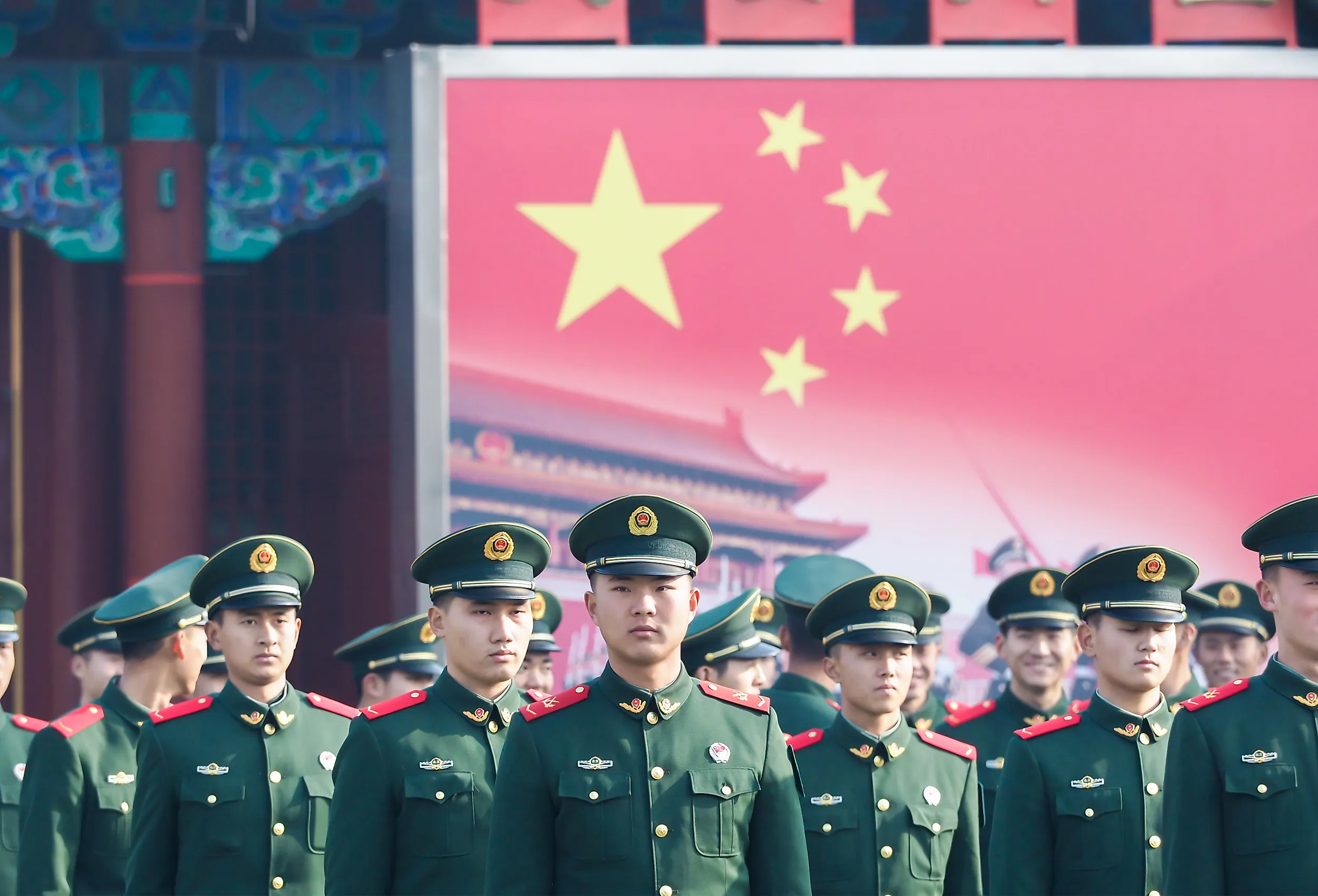
Treaties and political promises mean nothing if they cannot be upheld or protected with state-sanctioned force. Opportunist states, since the beginning of human civilization, have been quick to take advantage of vulnerable neighbors regardless of whether peace agreements were in place. Therefore, mass mobilization of national populations is an integral part of existing as a country in the 21st century. The presence of military might is an ongoing balancing act between maintaining peace and engaging in open warfare.
Religious, geopolitical, and economic disputes are not always solved diplomatically, which is why each of the following countries has invested in building up the largest and most powerful armies that the world has ever seen. This ranking considers active personnel to be the key metric, and the combined military might of reserve units is not considered. Furthermore, the tooth-to-tail ratio (combat units as opposed to supporting units) can vary, with a single soldier often relying on the assistance of two or even fifteen additional support personnel, on average.
China - 2 Million Active Personnel
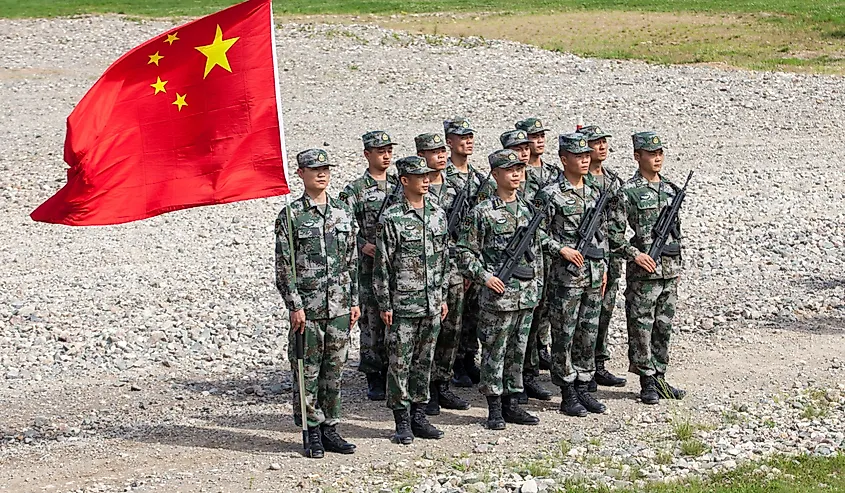
A platoon of Chinese soldiers with the Chinese flag. Image credit SemikArt via Shutterstock
An article in 1999, written by expert Bates Gill, declared China’s military to be a hollow and empty threat to its opponents, despite the former total of 2.8 million soldiers. Today, the 2 million units that comprise the Chinese military are better trained and better equipped. GlobalFirepower (GFP), an independent analytical group, ranked them 3rd in strength out of 142 countries. The People’s Liberation Army (PLA), the moniker for the Chinese forces, represents its Infantry, Navy, Air Force, Rocket Force, and Strategic Support Force. Every year, the PLA goes through a budget of around $229 billion in order to maintain its capacity. Despite the high number of personnel, there is no ongoing conscription of the civilian population. The GFP ranks consider only conventional deployments, as opposed to nuclear capabilities.
India - 1.45 Million Active Personnel
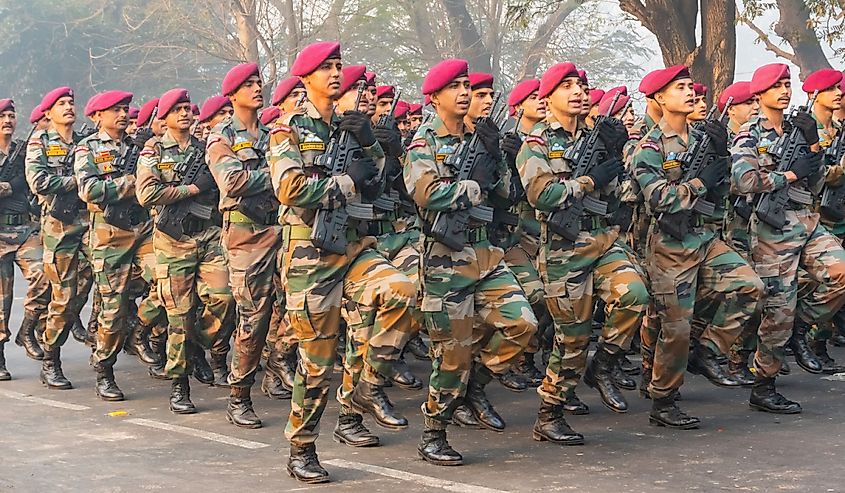 Indian armed forces are marching with light machine guns for India's republic day celebration. Image credit Rudra Narayan Mitra via Shutterstock
Indian armed forces are marching with light machine guns for India's republic day celebration. Image credit Rudra Narayan Mitra via ShutterstockThe border between India and China is in a heated state of competition, which is one reason why India maintains almost one and a half million active personnel. In 2021, footage reported by CNN recorded a violent confrontation between Indian and Chinese troops. The Indian Armed Forces, comprised of the Army, Navy, and Air Force, costs around $66 Billion to maintain each year. In 2019, that equated to roughly 2.4% of India’s total GDP. This expense does not go without merit, as India managed to place 4th on the GFP index. However, the vast distance between the strength of China and India is still palpable.
United States - 1.39 Million Active Personnel
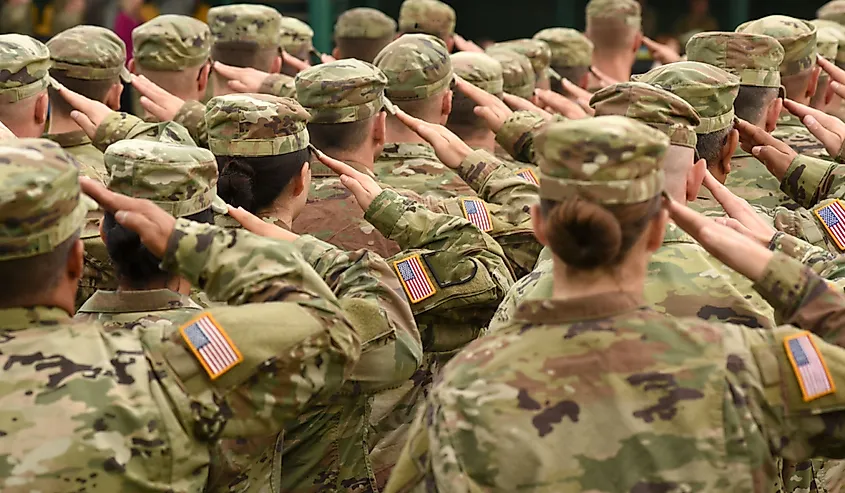
US soldiers giving a salute. Image credit Bumble Dee via Shutterstock
The lionized war machine of the United States stands in third place with its active military personnel at roughly 1.39 million units. This is significantly complemented by its 2022 budget of $782 Billion, which is triple the amount of the PLA. However, the reserve unit bolsters around 1.1 million members which is identical to India's, while China has a little over 1.2 million. GFP considers the US forces to be the strongest military in the world and considering its eleven sophisticated aircraft carriers compared to China’s two, the reasoning is sound. A VICE interview with a military analyst, Dylan Lehrke, revealed that it is unlikely the combined forces of the world could launch a successful invasion against the United States. Although, projecting force is much more difficult than defending a large territory.
North Korea - 1.2 Million Active Personnel
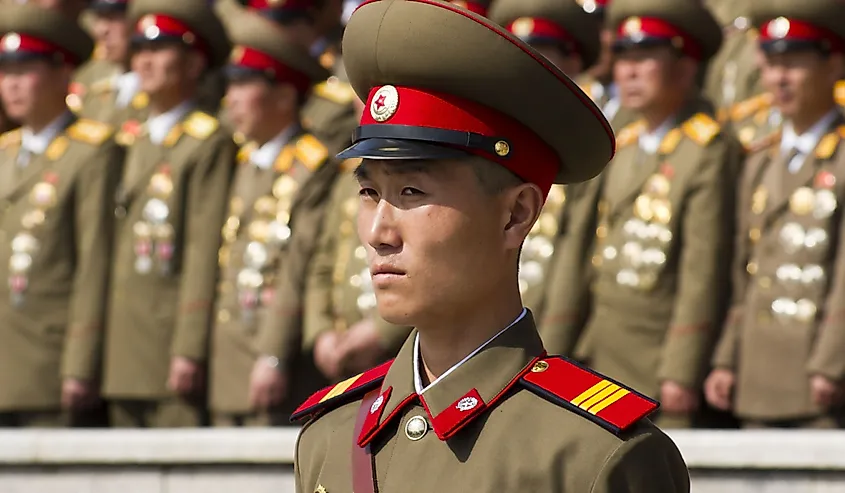 North Korean soldier at the military parade in Pyongyang. Image credit Astrelok via Shutterstock
North Korean soldier at the military parade in Pyongyang. Image credit Astrelok via ShutterstockNearly 30% of the North Korean population is in their armed forces, giving them the 4th largest military in the world. However, sheer numbers are not enough to grant them a top ten position, thus, they are 30th in terms of strength between Algeria and Thailand. Ruled by an oppressive and isolationist regime, North Korea's economic struggles alongside mass poverty have resulted in significant famines over the past several decades. The nation sits between South Korea, its long-term rival, and China, which has a vested interest in tolerating North Korea’s presence. In the media, it is common for North Korea to announce its plans to attack western powers. In addition, dangerous missile tests have endangered the Japanese mainland, although a direct strike has not yet occurred.
Russia - 850 Thousand Active Personnel
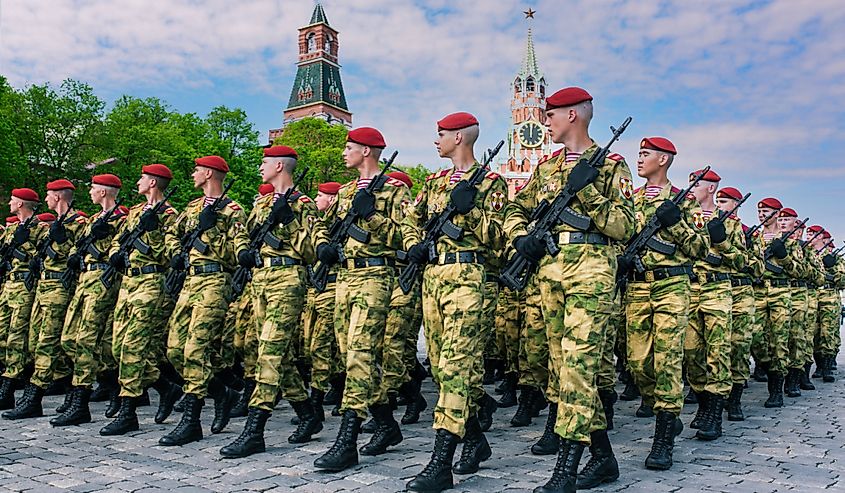 The Russian army in red berets and green uniforms, Moscow, Russia. Image credit Anton Brehov via Shutterstock
The Russian army in red berets and green uniforms, Moscow, Russia. Image credit Anton Brehov via ShutterstockCurrently considered the modern world’s greatest ‘paper tiger,’ Russia has a force that consists of roughly 850,000 active members. Updates in 2023 will likely reveal that approximately 100,000 Russian service members and conscripts died in the 2022 invasion of Ukraine. The reason for this colossal failure is due to internal and external overestimations of Russian military strength. Rampant corruption and misallocation of resources incapacitated the Russian military before the invasion. Rumors and reports have become abundant that Russia is desperate to make use of mercenary forces, alongside mass conscription of prison and civilian populations, in an effort to gain ground in Ukraine. However, when the dust settles, the international community will be unlikely to fear the Russian war machine as much as they did in years prior.
Pakistan - 640 Thousand Active Personnel
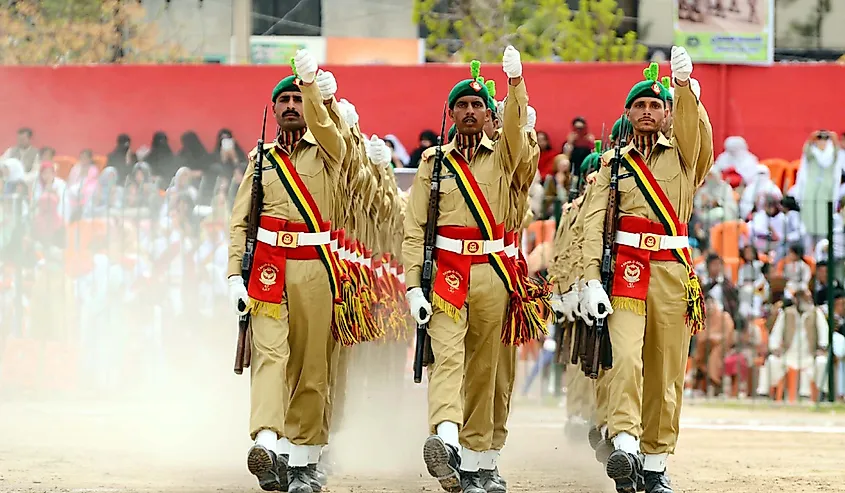 Pakistani military officials marching. Image credit Asianet-Pakistan via Shutterstock
Pakistani military officials marching. Image credit Asianet-Pakistan via ShutterstockThe Armed Forces of Pakistan is the 6th largest military in the world with 640,000 active personnel. In a similar model to other nations, the military comprises an army, navy, and air force. At $10.4 billion in cost per year (4% of total GDP), the arrangement is not insignificant economically or politically. However, despite the size, Pakistan is 9th according to GFP behind the United Kingdom, France, South Korea, and Japan. Due to long-term cultural and geographical disputes Pakistan’s primary opponent is India (and therefore Iran) as well as Afghanistan. Although open conflict simmers and tensions brew, the last significant confrontation between India and Pakistan occurred in 1965.
Iran - 575 Thousand Active Personnel
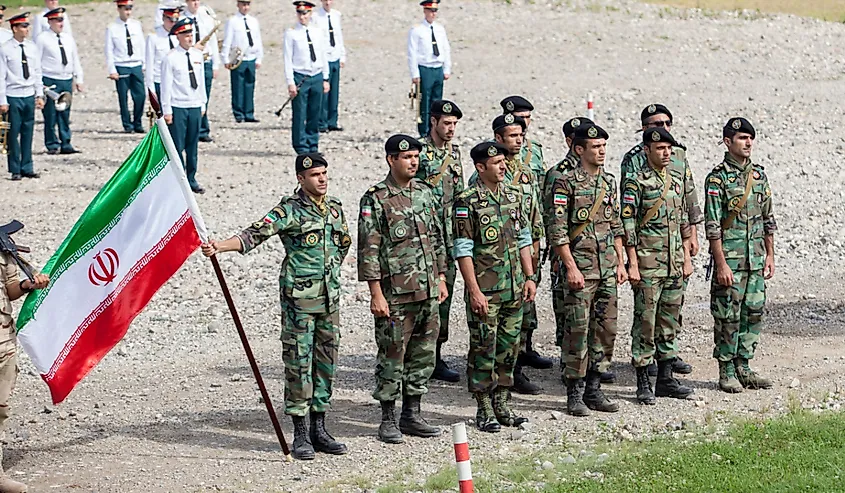 A platoon of soldiers of the Iranian army with the flag of the Islamic Republic of Iran. Image credit SemikArt via Shutterstock
A platoon of soldiers of the Iranian army with the flag of the Islamic Republic of Iran. Image credit SemikArt via ShutterstockThe subject of civil unrest is currently Iran’s greatest challenge, with protests breaking out across the country in 2021 and 2022. The active force of nearly 600,000 military personnel stands at the ready, however, to guard against all internal and external threats. The force cost $25 Billion in 2022, which accounted for 2.5% of its GDP. Tensions between Iran, Israel, the United States, and Saudi Arabia have persisted for decades due to complex differences in ideology, politics, and geographical disputes. This state of passive (and sometimes active) conflict is a prime motivator for each named country to increase its military efforts in the region. In particular, Iran is seemingly outnumbered. However, Iran does not currently have a nuclear weapon arsenal. Behind Egypt and Turkey, Iran is the 14th strongest military power according to GFP.
NATO - 3.3 Million Active Personnel
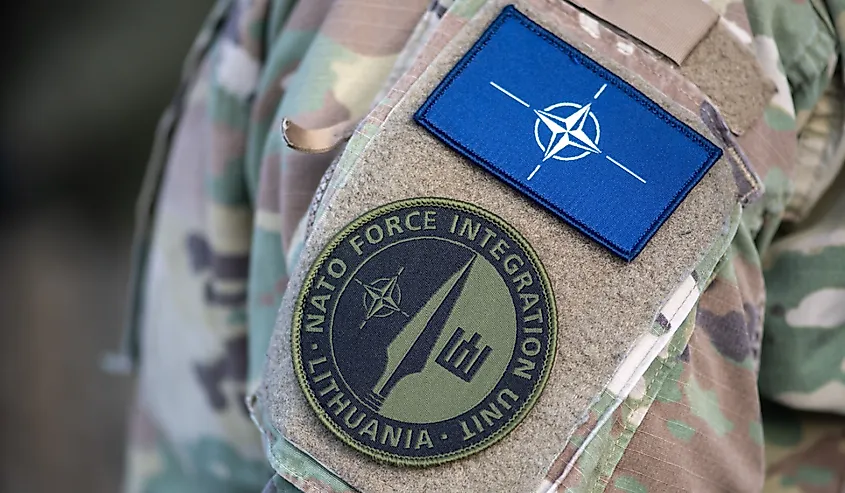 Patch flag and symbol of NATO force integration unit in Lithuania. Image credit Michele Ursi via Shutterstock
Patch flag and symbol of NATO force integration unit in Lithuania. Image credit Michele Ursi via ShutterstockNearly 3.3 million personnel make up the combined troop numbers of NATO. The arrangement consists of 30 nations that have agreed to a defensive military alliance. These nations are Albania, Belgium, Bulgaria, Canada, Croatia, Czechia, Denmark, Estonia, France, Germany, Greece, Hungary, Iceland, Italy, Latvia, Lithuania, Luxembourg, Montenegro, Netherlands, North Macedonia, Norway, Poland, Portugal, Romania, Slovakia, Slovenia, Spain, Türkiye, the United Kingdom, and the United States. The structure is unique because NATO’s forces encompass an integrated enchainment of all member nations, rather than a singular body. However, because member nations such as France and Germany are much lower down on the list with only 205,000 and 183,000 respective troops, their combined forces are a commanding presence internationally. The combined defense expenditure for members of NATO in 2022, including the United States, was $1.2 trillion.
Conclusion
Perhaps an era will come that sees the total dismantlement of all the world’s armed forces and nuclear arsenals. That day has not yet come, and modern societies continue to brace themselves for ongoing or eventual conflict. Despite the tentative peace achieved worldwide since the end of WWII, it may take only one nuclear-armed leader to unleash a devastating global chain reaction. Plenty of tensions and disputes still exist between countries today, alongside a handful of open conflicts, which cements the need for each state’s investment in an armed force. In the future, space forces will likely become more prevalent as the warring nature of humankind turns its attention to the stars. Regardless, universal peace must remain the focus of every world citizen in the coming millennia.
RankCountryNumber of Active Military Personnel
1 China 2,000,000
2 India 1,450,000
3 United States 1,390,000
4 North Korea 1,200,000
5 Russia 850,000
6 Pakistan 640,000
7 Iran 575,000
8 South Korea 555,000
9 Vietnam 470,000
10 Egypt 450,000
11 Turkey 425,000
12 Myanmar 400,000
13 Indonesia 400,000
14 Brazil 360,000
15 Thailand 350,000
16 Colombia 295,000
17 Sri Lanka 250,000
18 Mexico 250,000
19 Japan 240,000
20 Saudi Arabia 225,000
21 France 205,000
22 Ukraine 200,000
23 Morocco 200,000
24 Iraq 200,000
25 United Kingdom 194,000
No comments:
Post a Comment